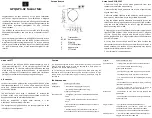
Phantom Power: Friend or Foe?
The AEA R44, like most ribbon microphones, neither needs nor wants phantom power. (More about
the A440 Active Studio Ribbon Microphone in the next paragraph.) What will happen if you connect
this microphone to a phantom-powered input? In a perfect world, nothing will go wrong, and the mi-
crophone will work just fine. However, if there is any defect in the integrity of the microphone cable or
connection, or if the phantom power is not properly balanced, this could produce a voltage differential
across the output of the microphone which can cause the ribbon to stretch or snap. The best prevention
against this type of damage is to be certain that the phantom power has been turned off for
at least two
minutes before you connect your microphone
. This will allow time for any stored voltage to drain from
the blocking capacitors inside the mixing console.
The AEA A440, on the other hand, has internal electronics to amplify the signal and provide more
output. This circuit requires conventional P48 phantom power (48 VDC, 9mA) to operate. Although a
defective cable or unbalanced phantom power also can cause this microphone to perform poorly, just as
they would with any condenser microphone, these will not damage the ribbon of the microphone.
Environmental Hazards
The ribbon is a thin strip of aluminum foil, 59.7 mm long, 4.7 mm wide, and 1.8-microns thick. It is
tensioned lightly so that it can respond to even the most delicate high-frequency soundwaves, yet be
able to withstand a sustained sound pressure level of more than 130 dB. What can damage the ribbon,
however, is a strong gust of air, such as from a nearby open door, window, or air conditioning vent, the
close pulse from a bass drum, the turn-on thump from a guitar or bass amplifier, moving or carrying the
mic unprotected swiftly through the studio, or someone blowing into it to test if it is working.
While it is unlikely that such a blast of air will break the ribbon, it certainly can cause it to stretch.
When this happens, the performance of the microphone will be degraded until the ribbon is replaced.
When it is in use, avoid any situation where volumes of moving air can blow directly into the micro-
phone. To prevent wind from damaging the ribbon, keep the mic covered with a plastic or cloth bag
when it is not in use.
Covering the mic will prevent it from attracting “tramp iron” from the environment into the magnet
structure. These tiny filaments of metal are all around us, resting on most flat surfaces. The strong
magnetic field inside a ribbon microphone can draw these through the grille and into the gap where the
ribbon is located. Eventually, enough of them can build-up to form whiskers in the gap that will rub
against the ribbon, causing distortion and crackling noises. Bagging the mic whenever it is not being
used will keep these out.
Gravity also can have its effects. The ribbon in your microphone is supported at its ends, but is free
over its 2+ inch length. If stored horizontally over a very long period of time, the ribbon might sag due
to its own weight. Microphone ribbons have no inherent life cycle. Good ribbon elements that are over
30 years old are not uncommon. The custom case provided with your new microphone provides proper
support for the microphone when in storage or transit, and keeps it in the recommended vertical orien-
tation.



































